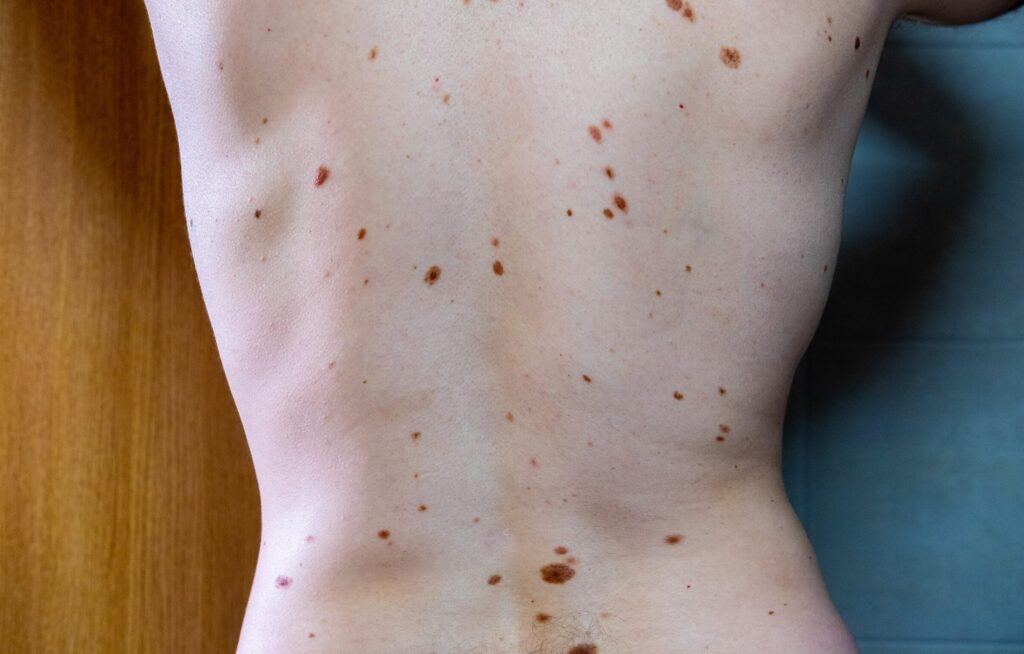Moles, those small pigmented spots on our skin, are often harmless. However, it’s crucial to distinguish between benign moles and potentially dangerous melanoma skin cancer. In this post, we’ll explore key methods for distinguishing between the two, including the “ugly duckling phenomenon,” the ABCDE’s of skin cancer, and advanced diagnostic techniques used by healthcare professionals.
Understanding Moles vs. Melanoma:
Moles, also known as nevi, are common skin growths composed of melanocytes, the pigment-producing cells in our skin. “While most moles are harmless, melanoma is a type of skin cancer that can develop from these cells and can be life-threatening if not detected and treated early,” explains Dr. Adam Mamelak, skin cancer specialist in Austin, Texas.
The Ugly Duckling Phenomenon:
The “ugly duckling phenomenon” is a helpful concept for identifying potentially concerning moles. Essentially, it involves looking for moles that stand out from the rest, either in size, shape, color, or texture. While most moles on an individual’s skin may look similar, the presence of an outlier, or an “ugly duckling,” could be a warning sign of melanoma.
The ABCDE’s of Skin Cancer:
Healthcare professionals often use the ABCDE mnemonic to assess moles and identify potential signs of melanoma:
– A: Asymmetry – Benign moles are usually symmetrical, while melanomas may have an irregular shape or be asymmetrical.
– B: Border – Benign moles typically have smooth, well-defined borders, while melanomas may have irregular, scalloped, or poorly defined borders.
– C: Color – Benign moles are usually uniform in color, while melanomas may have uneven coloring, with shades of brown, black, red, blue, or white.
– D: Diameter – Benign moles are generally smaller in diameter (less than 6mm), while melanomas may be larger.
– E: Evolution – Changes in size, shape, color, or elevation of a mole over time may indicate melanoma.
Advanced Diagnostic Techniques:
Beyond visual inspection, healthcare professionals may utilize advanced diagnostic techniques to assess moles and detect melanoma:
– Dermoscopy: Dermoscopy, or dermatoscopy, is a non-invasive technique that involves examining the skin using a handheld device called a dermatoscope. This tool allows for the visualization of structures within the skin that may not be visible to the naked eye, helping to identify features suggestive of melanoma.
– DermTech Testing: DermTech is a non-invasive genomic test that analyzes the RNA expression of skin cells collected from the surface of suspicious lesions. This test can help differentiate between benign moles and melanoma with high accuracy, aiding in early detection and treatment.
-Skin Biopsy: A skin biopsy involves removing a sample of tissue from a suspicious mole or lesion for microscopic examination by a pathologist. This procedure is considered the gold standard for diagnosing melanoma and other skin cancers. There are several types of skin biopsies, including:
- Punch Biopsy: A small, cylindrical tool is used to remove a sample of tissue from the suspicious area.
- Shave Biopsy: A scalpel or razor blade is used to shave off the top layers of the skin to obtain a sample.
- Excisional Biopsy: The entire lesion, along with a margin of normal skin, is surgically removed and examined.
- Incisional Biopsy: A portion of the lesion is surgically removed for examination.
Skin biopsies provide valuable information about the cellular characteristics of the lesion, helping to confirm the diagnosis of melanoma and determine its subtype, depth, and extent of invasion. This information is crucial for guiding treatment decisions and predicting prognosis. In some cases, additional tests, such as immunohistochemistry or molecular testing, may be performed on the biopsy sample to further characterize the tumor and guide personalized treatment approaches.
Conclusion:
Distinguishing between benign moles and melanoma skin cancer is essential for early detection and treatment. By understanding the “ugly duckling phenomenon,” the ABCDE’s of skin cancer, and utilizing advanced diagnostic techniques such as dermoscopy, DermTech testing, and skin biopsy, healthcare professionals can effectively assess moles and identify potential signs of melanoma. Regular skin examinations and self-checks are crucial for maintaining skin health and detecting skin cancer early. If you notice any changes in your moles or have concerns about a particular lesion, don’t hesitate to consult a healthcare professional for evaluation and appropriate management.

